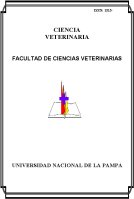Evaluación de dos formas de administración (bolos de liberación lenta vs. EDTA Cu inyectable) en la prevención de la deficiencia de cobre en bovinos para carne
Keywords:
Copper deficiency, Copper oxide, EDTA CuAbstract
The copper (Cu) deficiency is the most widespread mineral deficiency in the livestock zones of Argentina. The prevention strategies commonly used are based in the utilization of slow release injectable products. The objective of this trial was to compare the preventive efficacy of oral CuO and EDTA Cu injectable treatments in beef cattle. Ninety Aberdeen Angus and Hereford steers, with 217.14 + 36.78 kg of weight, were alloted to three groups of 30 animals each: Control (C), boluses with CuO particles (T1) and injectable copper (T2). The bovines of the T1 group were given initially one bolus of 20 g, containing CuO micropellets of 3 mm. The bovines of the T2 group were injected with Ca-Cu EDTA, 25 mg Cu/100 kg, every 90 days. The trial lasted 12 months (5/4/2004 to 5/13/2005) and was performed in one farm, close to General Pico, La Pampa, with Cu deficiency records. The animals were weighted monthly and 10 members of each group were bleeded at this moment for the subsequent Cu serum determination. The forage was monthly sampled for the measurement of Cu, molibdenum, iron and sulfur concentrations. The levels of total minerals and sulfates in water were determined The variables daily weight gain (DWG) and serum Cu were analyzed with a mixed model of repeated measurements (PROC MIXED, SAS System). The mineral concentrations in forage demonstrated a secondary orconditioned Cu deficiency. The sulfate levels in water were high, with the exception of three months. The DWG, in g, was 510.2 +- 72.3; 551,1 +- 52,8 and 577.3 +- 50.8 in the C, T1 and T2 groups, respectively. The serum Cu, in µg/ml, was 0.571 +- 0.110; 0.832 +- 0.093; T2: 0.854 +- 0.132 in the C, T1 and T2 groups, respectively. In both parameters, the T1 and T2 groups were similar, but higher than the C group (p0.05 and p0.001). The Cu serum levels of de the T2 group exhibited a waves pattern. In the T1 group the Cu serum concentrations were elevated until de sixth month. Then, they dropped and maintained around of 0.70 µg/ml until the last determination. The oral CuO supplementation is equally valuable than the injectable supplementation, but the first maintains high and stable serum Cu levels at least for six months. Moreover, for no producing pronounced peaks, probably it reduces the intoxication risks in animalsDownloads
Downloads
Published
How to Cite
Issue
Section
License
Al momento de enviar sus contribuciones, los colaboradores deberán declarar , de manera fehaciente, que poseen el permiso del archivo o repositorio donde se obtuvieron los documentos que se anexan al trabajo, cualquiera sea su formato (manuscritos inéditos, imágenes, archivos audiovisuales, etc.), permiso que los autoriza a publicarlos y reproducirlos, liberando a la revista y sus editores de toda responsabilidad o reclamo de terceros , los autores deben adherir a la licencia Creative Commons denominada “Atribución - No Comercial CC BY-NC-SA”, mediante la cual el autor permite copiar, reproducir, distribuir, comunicar públicamente la obra y generar obras derivadas, siempre y cuando se cite y reconozca al autor original. No se permite, sin embargo, utilizar la obra con fines comerciales.



4.png)


7.png)



